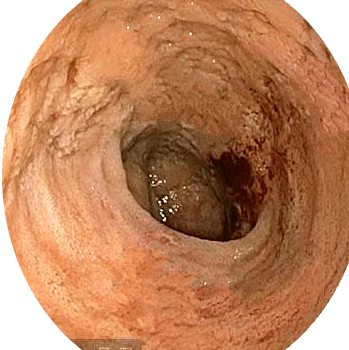Tuesday Poster Session
Category: General Endoscopy
P4152 - A Rare Presentation of Gastrointestinal Manifestations in Eosinophilic Granulomatosis With Polyangiitis: A Case Report
Tuesday, October 29, 2024
10:30 AM - 4:00 PM ET
Location: Exhibit Hall E

Has Audio

Muhammad YN Chaudhary, MBChB
Indiana University Southwest
Evansville, IN
Presenting Author(s)
Muhammad YN. Chaudhary, MBChB1, Muhammad Ismail, MD2, Oluwagbenga Serrano, MD, FACG3
1Indiana University Southwest, Evansville, IN; 2Indiana University Southwest, Cedar Rapids, IA; 3Good Samaritan Hospital, Vincennes, IN
Introduction: Eosinophilic Granulomatosis with Polyangiitis (EGPA), formerly Churg-Strauss syndrome, is a rare systemic vasculitis marked by eosinophilic infiltration and granuloma formation, typically affecting the respiratory tract, skin, and peripheral nerves. Gastrointestinal (GI) involvement is uncommon and presents a diagnostic challenge due to nonspecific symptoms. This case report highlights a rare presentation of EGPA with predominant GI manifestations, underscoring the importance of considering EGPA in patients with unexplained GI symptoms.
Case Description/Methods: A 45-year-old female with a history of asthma presented with a three-month history of recurrent abdominal pain, diarrhea, and unintended weight loss. Physical examination revealed mild epigastric tenderness without palpable masses. Laboratory investigations showed peripheral eosinophilia (eosinophil count of 1800 cells/μL), elevated inflammatory markers, and mild hypoalbuminemia. Stool studies were negative for infectious pathogens. Upper GI endoscopy revealed diffuse erythema, friability, and multiple aphthous ulcers throughout the esophagus (Image 1), stomach, and duodenum. Biopsies demonstrated prominent eosinophilic infiltration consistent with EGPA. Serological testing revealed positive perinuclear ANCA (p-ANCA) with myeloperoxidase (MPO) specificity. Imaging studies showed no evidence of vasculitic involvement in other organs. The patient was diagnosed with EGPA and treated with corticosteroids and immunosuppressants, leading to significant clinical improvement.
Discussion: This case is novel due to the predominant GI involvement in EGPA, which is rare and often overlooked. The nonspecific GI symptoms posed a significant diagnostic challenge, mimicking more common conditions like inflammatory bowel disease or infections. The histological finding of eosinophilic infiltration in GI biopsies and positive p-ANCA with MPO specificity were crucial for diagnosis. This case underscores the importance of considering EGPA in the differential diagnosis of patients with unexplained GI symptoms and peripheral eosinophilia. This case contributes valuable insights to the medical literature, emphasizing the diverse presentations of EGPA and the importance of thorough diagnostic evaluation in patients with atypical GI symptoms.

Disclosures:
Muhammad YN. Chaudhary, MBChB1, Muhammad Ismail, MD2, Oluwagbenga Serrano, MD, FACG3. P4152 - A Rare Presentation of Gastrointestinal Manifestations in Eosinophilic Granulomatosis With Polyangiitis: A Case Report, ACG 2024 Annual Scientific Meeting Abstracts. Philadelphia, PA: American College of Gastroenterology.
1Indiana University Southwest, Evansville, IN; 2Indiana University Southwest, Cedar Rapids, IA; 3Good Samaritan Hospital, Vincennes, IN
Introduction: Eosinophilic Granulomatosis with Polyangiitis (EGPA), formerly Churg-Strauss syndrome, is a rare systemic vasculitis marked by eosinophilic infiltration and granuloma formation, typically affecting the respiratory tract, skin, and peripheral nerves. Gastrointestinal (GI) involvement is uncommon and presents a diagnostic challenge due to nonspecific symptoms. This case report highlights a rare presentation of EGPA with predominant GI manifestations, underscoring the importance of considering EGPA in patients with unexplained GI symptoms.
Case Description/Methods: A 45-year-old female with a history of asthma presented with a three-month history of recurrent abdominal pain, diarrhea, and unintended weight loss. Physical examination revealed mild epigastric tenderness without palpable masses. Laboratory investigations showed peripheral eosinophilia (eosinophil count of 1800 cells/μL), elevated inflammatory markers, and mild hypoalbuminemia. Stool studies were negative for infectious pathogens. Upper GI endoscopy revealed diffuse erythema, friability, and multiple aphthous ulcers throughout the esophagus (Image 1), stomach, and duodenum. Biopsies demonstrated prominent eosinophilic infiltration consistent with EGPA. Serological testing revealed positive perinuclear ANCA (p-ANCA) with myeloperoxidase (MPO) specificity. Imaging studies showed no evidence of vasculitic involvement in other organs. The patient was diagnosed with EGPA and treated with corticosteroids and immunosuppressants, leading to significant clinical improvement.
Discussion: This case is novel due to the predominant GI involvement in EGPA, which is rare and often overlooked. The nonspecific GI symptoms posed a significant diagnostic challenge, mimicking more common conditions like inflammatory bowel disease or infections. The histological finding of eosinophilic infiltration in GI biopsies and positive p-ANCA with MPO specificity were crucial for diagnosis. This case underscores the importance of considering EGPA in the differential diagnosis of patients with unexplained GI symptoms and peripheral eosinophilia. This case contributes valuable insights to the medical literature, emphasizing the diverse presentations of EGPA and the importance of thorough diagnostic evaluation in patients with atypical GI symptoms.

Figure: Image 1: Diffuse erythema, friability, and multiple aphthous ulcers throughout the esophagus.
Disclosures:
Muhammad Chaudhary indicated no relevant financial relationships.
Muhammad Ismail indicated no relevant financial relationships.
Oluwagbenga Serrano: MERCK – Stock-publicly held company(excluding mutual/index funds).
Muhammad YN. Chaudhary, MBChB1, Muhammad Ismail, MD2, Oluwagbenga Serrano, MD, FACG3. P4152 - A Rare Presentation of Gastrointestinal Manifestations in Eosinophilic Granulomatosis With Polyangiitis: A Case Report, ACG 2024 Annual Scientific Meeting Abstracts. Philadelphia, PA: American College of Gastroenterology.

